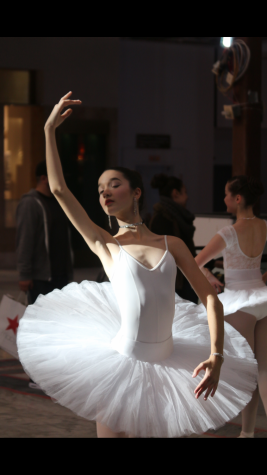Staying in Shape
The Talon delves into the intensive workouts of three top athletes at Los Altos. Read on to learn more about what exercises they do to stay in shape and achieve excellence in their sport.
February 11, 2019
Kai Moos

To play competitive soccer for the nationally-recognized De Anza Force Academy Team, senior Kai Moos must devote much of his schedule to not only soccer, but staying fit and working out. On top of playing soccer five to six days a week, Kai lifts weights, boxes and does upward of 700 push-ups every day to maintain his athletic build for soccer.
By integrating playing cards into his workout, he is able to make the 700 pushups more manageable. Kai splits the deck into four piles of 13 cards, with an ace as one push-up, jack as 11, queen as 12 and king as 13.
“My philosophy is that if there’s free time when I’m done with homework or if I’m watching TV, I might as well at least be doing push-ups or getting some core work in,” Kai said.
By creating a workout routine outside of soccer, Kai has motivated himself to work harder on the field. The workouts, used to strengthen specific muscle groups for soccer, have been proven to raise both his physical and mental stamina during games.
In the past, Kai had trouble following through with his goals. Once he began acting upon his fitness goals, he was able to see a change in his athletic performance.
“I started waking up at 6 a.m. to work out and forced myself to endure the pain and just do it because talking doesn’t get you anywhere, but actually doing it does,” Kai said.
Sarah Patterson
As a dedicated student and ballet dancer, sophomore Sarah Patterson uses a mix of eccentric exercises to stay in shape, focusing on flexibility, strength, and alignment.
At the age of two, Sarah decided she wanted to become a ballet dancer after watching the Boston Ballet’s Nutcracker. Sarah began taking ballet lessons when she was three and joined a professional school when she was four. Now, Sarah still attends the New Ballet School in San Jose and works hard to maintain a work-life balance during the school year.
Sarah practices an average of 24 hours a week during the school year, Monday through Saturday. Her hours fluctuate depending on her performance schedule and rehearsal season. Sometimes they can reach a maximum of 36 hours a week, including Sunday. Sarah’s favorite part of ballet practice is when they do across the floor exercises because she’s already warmed up by then. Since Sarah has practiced exercises in previous rehearsals, she can focus simply dancing and enjoying the music.
Despite her intensive ballet rehearsals, Sarah does exercises outside of practice to stay in shape, balance her muscle groups, and address injuries. Of these exercises, Sarah most often engages in pilates, floor barre, and gyrotonics.
Sarah began pilates in 7th grade to work on foot articulation and strengthening her achilles, her feet, and her calves—this addressed both her injuries and her footwork. At this time, she was beginning to go on pointe. Pointe is a ballet technique where dancers balance their weight on the tips of their toes with the support of specialized pointe shoes. Since ballet spends lots of time targeting particular muscles, dancers are encouraged to engage in other activities to balance out their muscles. Pilates provides a solution to this need— like moving yoga, it focuses more on conditioning the abs, hamstrings, and glutes.
In conjunction with pilates, Sarah started floor barre in seventh grade. Floor barre exercises are often incorporated into pilates and helps with placement, alignment, and barre work. Floor barre is much like it sounds: barre work, but lying on one’s back. Barre work consists of ballet warm up exercises usually performed using the barre for balance.This consists of tandus, relevés, plies, and more.
After engaging in pilates or floor barre, Sarah feels a lot smoother and her muscles feel more balanced. It is characteristic of ballet to focus in depth on certain muscles while overlooking others. Therefore, it is important to do exercises out of ballet to address and strengthen the other muscles. This helps with balance! Floor barre is unique in the sense that it only attracts dancers because of its ballet-focused exercises. It helps with alignment, placement, posture, and working on certain turnout muscles in her hips and her core, and center of gravity.

Last year, Sarah began doing gyrotonics as well to improve her arm strength, core, placement, and posture. Gyrotonics uses specialized machines and is particularly helpful because of its ability to target specific muscles in isolated movements. Gyrotonics is not unique to dancers, and Sarah would recommend it for those who are looking to loosen up their body and balance their muscle groups.
Of these three exercises, Sarah performs each 3 times a week in 15-minute sessions, or whenever she gets the time. Sarah would definitely recommend pilates and gyrotonics to dancers and non-dancers alike because they help make one’s body well-rounded and flexible.
Although Sarah loves ballet, her extreme involvement in the sport is time consuming: when she gets home, it is already 9 p.m. In order to excel in both academics and ballet, Sarah emphasizes the importance of time management. She believes that anyone can devote their time to a sport as long as they are efficient, motivated, and utilize the time they have.
Even with school, ballet will continue to be a large part of Sarah’s life. She hopes to try out for the New Ballet Studio Company during a gap year between high school and college.
“When I dance, I feel the most myself. I just feel free, and I feel like I can do whatever I want,” Sarah said. “One of my greatest dreams has been to fly, and I feel like ballet is the closest I can get to that.”
John Larson
Junior John Larson started working out with his friends in seventh grade when he joined the Egan Jr. High School wrestling team and wanted to become stronger, faster and fitter. John now focuses on powerlifting, a sport which focuses on lifting which uses the squat, bench press and deadlifts.

Never having been interested in team sports, John found that his passion for powerlifting stemmed from the feeling of autonomy he got in dictating his own training.
“I love that in lifting it was always me versus me with no coach I had to answer to and no one telling me what to do,” John said. “I never felt any kind of pressure to do something, and I could go at my own pace. I can experiment with different types of training, different routines, regiments, eating plans. With lifting, it’s completely up to you about what you put in.”
Of the many different routines a lifter can choose from, John chose linear periodization, which is working out and adding weight in constant increments. With this routine, he consistently added five minutes to his main lifts, five pounds to both bench presses and squats and ten pounds to his deadlifts each week. Using this method, John has pushed himself to lifting 215 pounds for bench presses, 275 pounds for squats and 360 pounds for deadlifts.
“Adding a consistent amount of weight every time has allowed me to see a consistent increase in my lifts,” John said. “It’s allowed me to track my progress really well because if I notice that a lift is going down, I’ll be able to drop it down by a certain increment and slowly work my way back up using the linear progression method.”
However, lifting isn’t just a physical challenge. For many, lifting can be mentally exhausting, but John thrives off of the constant progress he sees in the gym. He believes that anyone can lift as long as they have the right mindset and good form.
“I would say that it has become somewhat of an addiction for me,” John said. “I just feed off of seeing progress and just get addicted to that idea of constantly progressing, and I just love the idea of constantly adding weight and constantly seeing improvements.”
In addition to the mindset, John also has to be wary of what he consumes. In an effort to eat foods with high protein, high carbs and low fat, John eats a lot of chicken, rice and sweet potatoes. His main focus is to intake more calories than he loses while working out.
John hopes to lift 250 pounds for bench press, 315 pounds for squats and 400 pounds for deadlifts by his first competition on Saturday, February 23.
“In terms of overall goals, I’m looking to do more powerlifting meets and eventually qualify for USAPL raw nationals,” John said. “I also hope to continue to train hard and consistently for years to come.”





